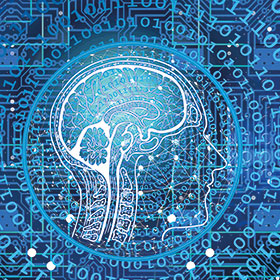

There is much competition in the artificial intelligence (AI) space, not least with respect to the name itself. Are we seeing the emergence of true AI, or is it just machine learning or sophisticated neural networks? The question is hotly debated, but let’s just say the marketing people have a more liberal view of what constitutes AI than the engineering community does. Without getting bogged down in nomenclature, what is beyond doubt is that the AI revolution is coming, and in the cutting-edge area of video analytics some would argue it’s already here.
To get the low-down on what’s happening in terms of applying AI to video analytics (VA), we posed a few questions to Johan Christiani, CCTV community manager at Fidelity ADT; Mahesh Saptharishi, chief technology officer at Avigilon; Andrew Mu, product marketing manager at Hikvision; Vanessa Tyne, senior account manager at Axis Communications; and Tony Yang, Southern African national manager at Uniview.
Is AI in VA a current reality, or more of a promise for the future?
Christiani: Intelligent surveillance and AI are developing at an alarming pace. Companies battle to stay ahead of one another and that adds more pressure on the offering and technologies of these CCTV brands.
Intelligent surveillance and AI includes many features, where an algorithm is developed to monitor the video and identify objects such as humans, vehicles and animals. Not only can AI distinguish between objects but it can learn behaviour and patterns, the system can either ignore the behaviour or patterns or notify the user depending on the requirement.
The more demand that is put on surveillance as a proactive measure, the more we can see the need for intelligent surveillance. The trend of relying more on machine-based processing and less on the human factor is evident and a reality. In our environment machines can process data more effectively than humans. However, humans are still a necessity to interact with these alerts and events to ensure maximum accuracy.
Mu: AI is already helping us get useful information in a timely way from volumes of data which are hard to analyse manually. AI is therefore making video surveillance much more efficient.

Saptharishi: There is no denying it, the role of AI in security today is transformative. AI-powered video management software is helping to reduce the amount of time spent on surveillance, making security operators more efficient and effective at their jobs. By removing the need to constantly watch video screens and instead automating the ‘detection’ function of surveillance, AI technology allows operators to focus on what they do best: verifying and acting on critical events.

Tyne: AI is definitely starting to make a difference to video analytics and how they are being used on customer sites. AI is driving analytics to become smarter and more functional. Currently it is able to analyse the data and identify patterns, but it will still require the assistance of VA to understand what an immediate threat is versus a learned threat.
However I do think that we are still way off from being able to fully utilise the AI available at this point, and the cost is prohibitive for many customers. An example of how AI goes beyond VA is facial recognition: typical facial recognition VA requires a database that it will reference to, whereas AI learns who is a known face, and will send an alert when an unknown face enters a building.

Yang: AI has already made a big difference compared with VA results and capabilities. Uniview’s AI is based on a neural algorithm to do deep learning by itself, which includes VA, but is not only limited to this content. In traditional CCTV, VA usually analyses existing video content, which is a constant. This can meet most basic requirements, but for huge data volumes and complex environments it is not powerful enough to meet customers’ requirements. AI, on the other hand, can achieve dynamic and self-adapting video analytics. From now on, AI will make a big difference for the CCTV industry.
How is AI/deep learning impacting the VA market?
Saptharishi: Today, there are more cameras and recorded video than ever before, which means security operators are faced with the challenge of keeping pace. On top of that, people have short attention spans. However, AI is a technology that can help overcome this challenge as it doesn’t get bored and can analyse more video data than humans ever possibly could.
The role of AI in security is transformative. AI-powered video management software, such as Avigilon Control Center (ACC), is helping to make security operators more efficient and effective at their jobs. By removing the need to constantly watch video screens and automating the ‘detection’ function of surveillance, AI technology allows operators to free up their time and focus on making decisions. This not only expedites forensic investigations but enables real-time event response as well.
When integrated throughout a security system, AI technology has the potential to dramatically change security operations. Just as high-definition imaging has become a quintessential feature of today’s surveillance cameras, the tremendous value of AI technology has positioned it as a core component of security systems today, and in the future.
Tyne: The impact is that customers are looking for more self-learning platforms that will make control room operations smoother and more proactive. Operators watching a video monitor for more than twenty minutes lose 95% of their ability to maintain attention sufficient to discern significant events. And these events have been set up to alarm via VA.
VA have moved from basic tripwire applications to more detailed and finely calibrated detection analytics that are able to assess directional movement and the differences between a human and a vehicle. When it comes to VA, many customers believe that this is the ‘AI’ that they are looking for, however, in many instances it isn’t. Many surveillance vendors have what they call AI – LPR (licence-plate recognition), intruder breaches on perimeter, etc. but this is just clever analytics.
AI is far more powerful and bases itself on the concept of self-learning, not a rule-based environment, and building a base of ‘normal’ versus ‘abnormal’ behaviours – be it a vehicle driving the wrong way down a one-way street, or a person entering premises outside of normal hours. AI typically has a lower false alarm rate, having identified the behaviours of the environment.
Yang: AI/deep learning is more applicable for vertical markets such as safe city surveillance, whereas VA is more for the small and medium sized business market. Although video analytics have been improved a lot in terms of functionality and capability in the past several years, AI is getting more accurate and intelligent compared with VA.
What AI-powered analytic products are available today from your company?
Christiani: Fidelity ADT currently uses an AI-based platform with the ability to distinguish between humans, vehicles and animals as well as activities like loitering, groups of people, manual work (for example, carrying an object) and many more. Time schedules can be allocated to these events as per customer or community requirements.
Response vehicles will be dispatched on alarms and notifications based on the Service Operation Procedure agreements with the customer or community. We aim to provide accurate response through AI. Not only do we monitor these events but we also train the system on every single alert according to how accurate the event is. This actually trains the system from a human’s perspective. We ensure that our offering best serves our customers and that the technology we use stays as close to the latest developments as possible.
Mu: The AI technologies offered by Hikvision include facial recognition, vehicle detection (including plate number, colour and type), perimeter intruder prevention, as well as others. Our blacklist alarm application helps to improve social security, while the VIP recognition application improves service levels, and face check-in and attendance improve manager efficiency.
Our queue detection helps to shorten queuing time, and human behaviour analysis is able to detect when someone falls down so that emergencies at e.g. schools or hospitals can be responded to quickly. Our loitering application is used in important places, such as banks and so on, to improve security.
Saptharishi: Advanced AI technology, like Avigilon Appearance Search technology, provides security operators with the ability to quickly locate a specific person or vehicle of interest across an entire site. This enhanced search capability is designed to help improve response times by answering the critical ‘who, what, where and when’ of an investigation with decisive action.
Avigilon Unusual Motion Detection (UMD) technology uses AI in video search to bring a new level of automation to surveillance, helping to reduce hours of work reviewing recorded video to minutes. Without any pre-defined rules or setup, UMD technology is able to continuously learn what typical activity in the scene looks like, and then detect and flag unusual motion. This allows operators to search through large amounts of video faster, as UMD focuses their attention on the atypical events that may need further investigation.
Through the use of high-definition video analytics, pattern-based analytics algorithms, and teach-by-example capabilities, we provide preventative protection through proven self-learning video analytics technology. Avigilon’s advanced video pattern-based algorithms recognise the movements and characteristics of people and vehicles while ignoring any activity that isn’t relevant to a scene. Teach-by-example technology enables users to provide feedback about the accuracy of alarms to refine the device’s self-learning capabilities.
The Avigilon Artificial Intelligence Appliance (AI Appliance) adds patented self-learning video analytics and Avigilon Appearance Search technology to nearly any IP camera. When connected to Avigilon Control Center (ACC) software, customers can evolve legacy camera systems into powerful AI solutions – with automatic alerts of potentially critical events and the ability to search for and locate a person or vehicle of interest across an entire site.
Tyne: Axis Communications partners with companies that specialise in AI platforms. All our cameras can take VA on the edge, which helps curb the cost of infrastructure. These analytics can then filter into any number of AI platforms.
Yang: These days Uniview has six series of AI-powered analytic products for CCTV, covering ITS (intelligent transport system), safe city, big date storage, clouding computing, cut-edge computing and more.
The products include the Kunlun server (face recognition, people counting, video management), Yanshan server (video cybersecurity), Qinling server (big data, cloud computing and storage), Tianmu box camera (ITS), Hangu box camera (face recognition - can recognise 40 people simultaneously), and Tongguan face recognition gate.
Compared with previous solutions, these new AI-powered products are more stable and accurate, and massively reduce labour cost when deployed in big projects processing huge data sets.
What can we expect to see from AI-powered VA going forward?
Saptharishi: As the world becomes increasingly connected, the way we think about and interact with our security systems will continue to evolve across various verticals and applications. The emergence of GPU technology, in particular, has led to a dramatic increase in performance and value. With the democratisation of video analytics and increased use of AI and deep learning, we believe that video analytics will be inherent in digital surveillance and used in broader applications.
Cybersecurity will become more important as we move toward a more connected approach to security – particularly as our collected data becomes more sophisticated and critical.
Tyne: The growth that will be made into behavioural and situational awareness AI will be the changing force into the future. AI has the capability to proactively intercept and predict incidents. Something as complex or subtle as a fight breaking out or an employee breaking a safety procedure is not possible for a rule-based analytic to detect.
Going into the future, we foresee AI embedded onto camera chipsets, however this will be a few years off, when the AI platforms are more mature.
Yang:<>i. In the future, AI will be the leading video analytics technology to make a whole system smart – AI can be thought of as a brain versus VA as more of an organ. AI-powered systems will be the cornerstone of the smart city, serving to greatly improve people’s lifestyle, just like Alipay and PayPal have guided us into the cashless payment age.
For more information contact:
• Avigilon, +27 83 229 8297, [email protected], www.avigilon.com
• Axis Communications SA, +27 11 548 6780, [email protected], www.axis.com
• Fidelity ADT, 086 121 2400, [email protected], www.adt.co.za
• Hikvision South Africa, +27 10 035 1172, [email protected], www.hikvision.com
• Uniview, +27 79 723 4175, [email protected], www.uniview.com
| Tel: | +27 11 543 5800 |
| Email: | [email protected] |
| www: | www.technews.co.za |
| Articles: | More information and articles about Technews Publishing |

© Technews Publishing (Pty) Ltd. | All Rights Reserved.